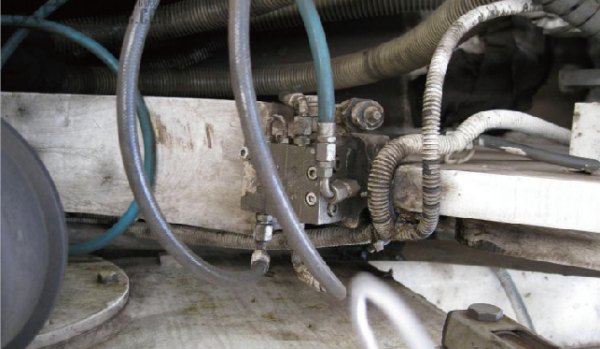This article briefly introduces specific fault analysis and troubleshooting methods through actual cases of partial failures in the centralized lubrication system of excavators during operation, hoping to be helpful to friends who also have such problems.
Fault 1:
During the operation of the electric shovel, a fault alarm suddenly sounded, and the operating console display screen showed: low pressure in the gas pipeline and upper dry oil lubrication failure. Go to the lubrication room to check the upper dry oil system using manual control. First check whether the oil tank is short of grease, then turn the upper dry oil control knob from the automatic position to the manual position, and then check the air source pressure supplying the pneumatic pump. The pressure is normal, the solenoid valve is energized, and the pneumatic pump starts working (the pump is normal) , when the pressure in the pipeline reaches the set value, the reversing valve reverses normally, but the pneumatic pump continues to work. After analysis, the fault of oil leakage in the main pipeline was first eliminated, but the pneumatic pump continued to work after the reversing valve was reversed (the electrical PLC program control is: during manual operation, the reversing valve reverses after the pressure in the pipeline reaches the set value. , its travel switch gives an electrical signal, the solenoid valve is powered off, and the pump stops working). It can be determined that there is a fault somewhere in the reversing valve. First check the travel switch. When the reversing valve is working, the travel switch works normally. Then check the signal sending device of the travel switch and open the box cover. It turns out that one of the external wires of the sending device has fallen off. After connecting it, retest, everything normal.
The reason for the low pressure in the gas pipeline occurred. After careful analysis, it turned out that after the reversing valve in the upper dry oil lubrication system failed, the solenoid valve kept energizing and the pneumatic pump kept working, causing the main pipeline pressure to be lower than The lowest value set by the pressure relay for air pressure monitoring. The minimum loading starting pressure of the air compressor is 0.8MPa, and the normal pressure set on the air pressure display meter of the air storage tank is also 0.8MPa (the main line air pressure monitoring is the lowest value of the normal air pressure). Since the pneumatic pump continues to work and consumes air, and the air compressor also has an automatic drainage process when reloading, it also needs to consume a certain amount of air. In this way, the air pressure of the main pipe is lower than 0.8MPa, and the air pressure detection device A low pipe pressure fault alarm will sound.
troubleshooting:
Adjust the minimum loading starting pressure of the air compressor to 0.85MPa, and the normal pressure set on the air pressure display meter of the air storage tank remains unchanged, which is still 0.8MPa. During the subsequent operation, there was no alarm failure of low main line pressure.
Fault 2:
During a routine inspection, it was found that the reversing valve in the upper dry oil lubrication system took more than ten seconds longer than usual. The first reaction was whether there was an oil leak in the main pipeline. , checked along the main pipeline from the reversing valve to each distributor, and found no oil leakage. Check the oil tank. The grease is sufficient. There may be pipeline blockage. Disassemble the oil pipe connecting the pneumatic pump and the reversing valve. After manual operation, the oil output is normal. The problem may lie in the reversing valve. First, disassemble the filter device at the oil inlet of the reversing valve, take out the filter element, and find that there are many debris on the filter element, and the entire filter element is almost half blocked. (It may be impurities that fell into the tank due to the carelessness of the operator when refueling). After cleaning, install it, connect the pipeline, start the pneumatic pump, and it works normally.
During the operation of the excavator, alarms for lubrication failures are often issued, which may not necessarily be caused by problems with the pipelines or lubrication components in the lubrication system. When this happens, first check whether the oil tank is short of oil, and then check the lubricating components (including the solenoid valve that supplies air to the pneumatic pump) and the air source pressure of the pneumatic pump in sequence. If everything is normal, you need to cooperate with the electrical personnel to work together. Check the electrical system wiring for components associated with the lubrication system. In addition to finding and dealing with problems in a timely manner after a fault is discovered in the lubrication system, necessary inspections and maintenance of the lubrication system should be carried out to detect and eliminate hidden dangers early to ensure the normal operation of the equipment.
The centralized lubrication system uses centralized oil supply from oil pumps and fixed-point lubrication in a closed system, which avoids problems such as lubricant contamination and missing lubrication points caused by manual oil filling. Using PLC program control, regular and quantitative oil supply avoids problems such as waste of lubricating oil and inaccurate lubrication time caused by manual oil filling. Whether faults that occur during the operation of the centralized lubrication system can be handled in time will play a very important role in improving the efficiency of the equipment.
If your excavator needs to purchase related excavator accessories during maintenance and repair, you can contact us. If you need to buy a new excavator or a second-hand excavator, you can also contact us. CCMIE provides comprehensive excavator sales services.
Post time: Sep-19-2024

